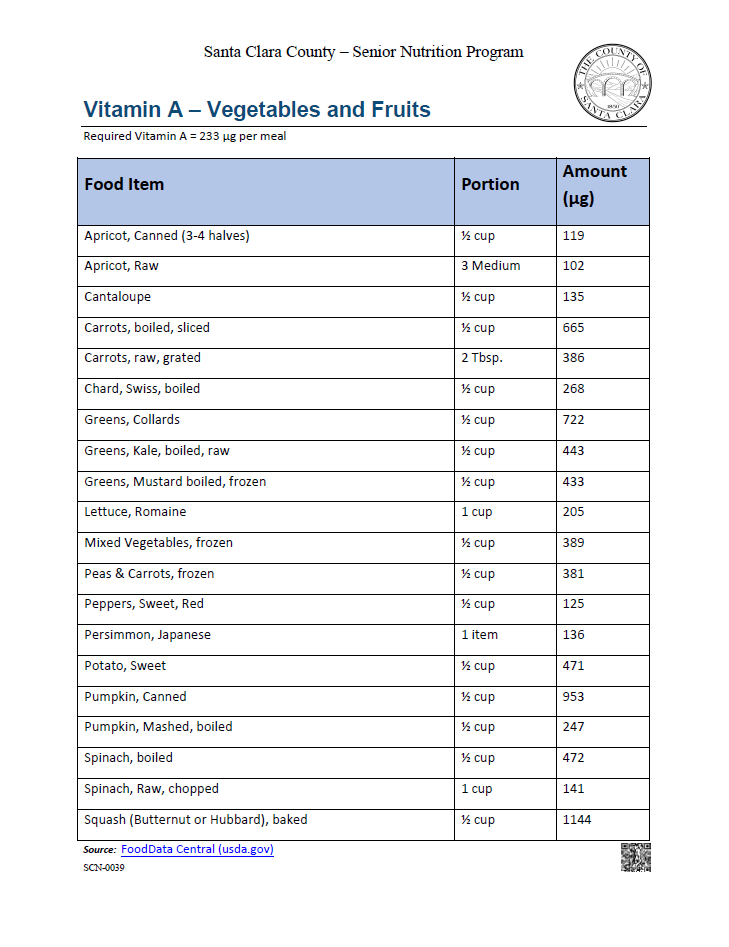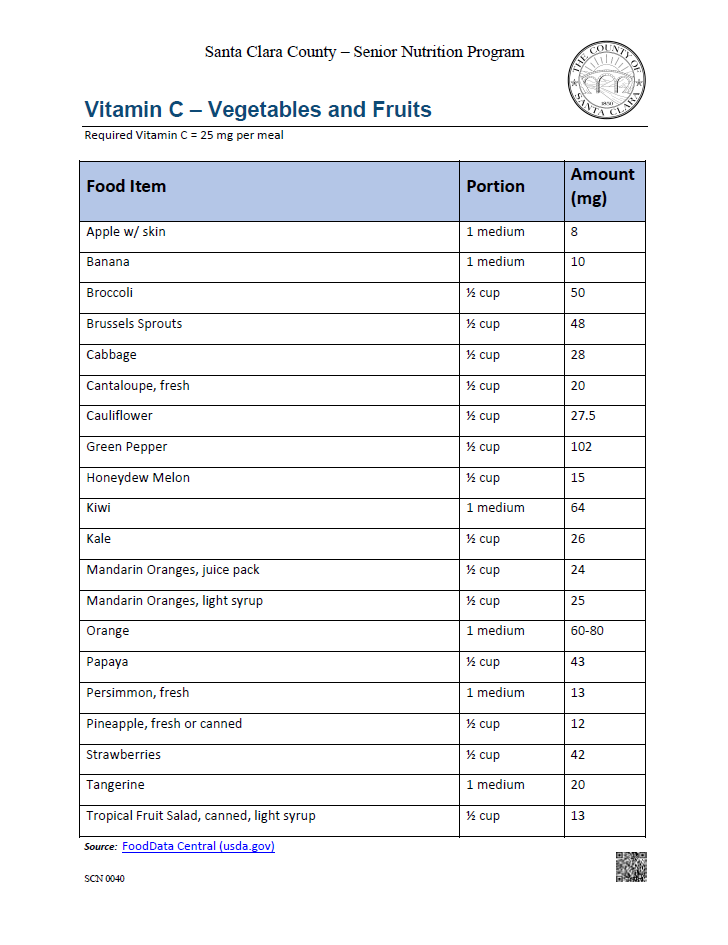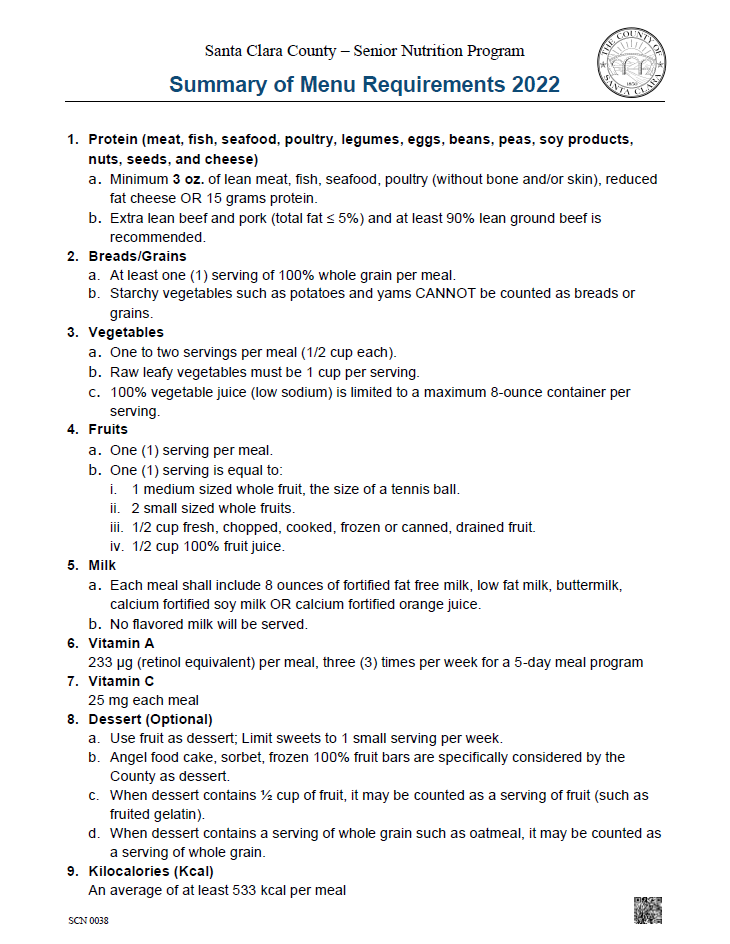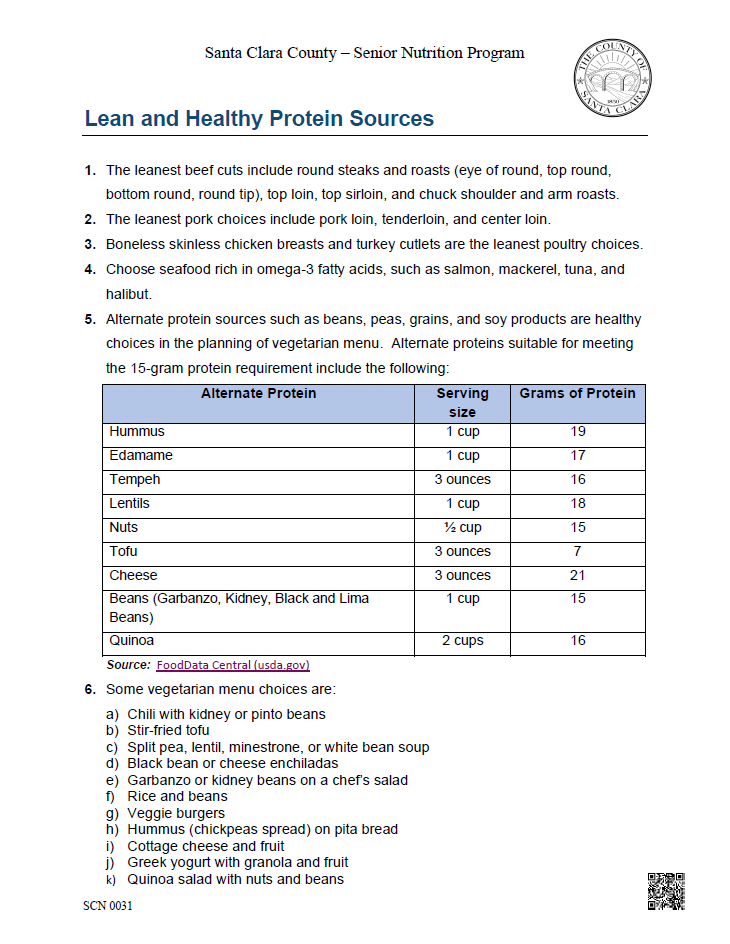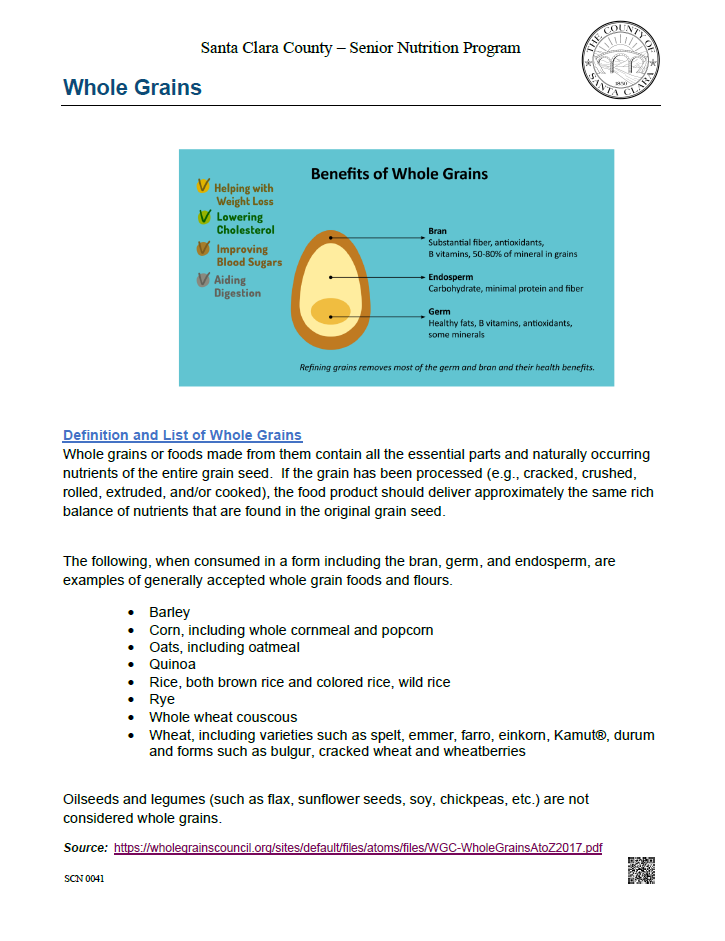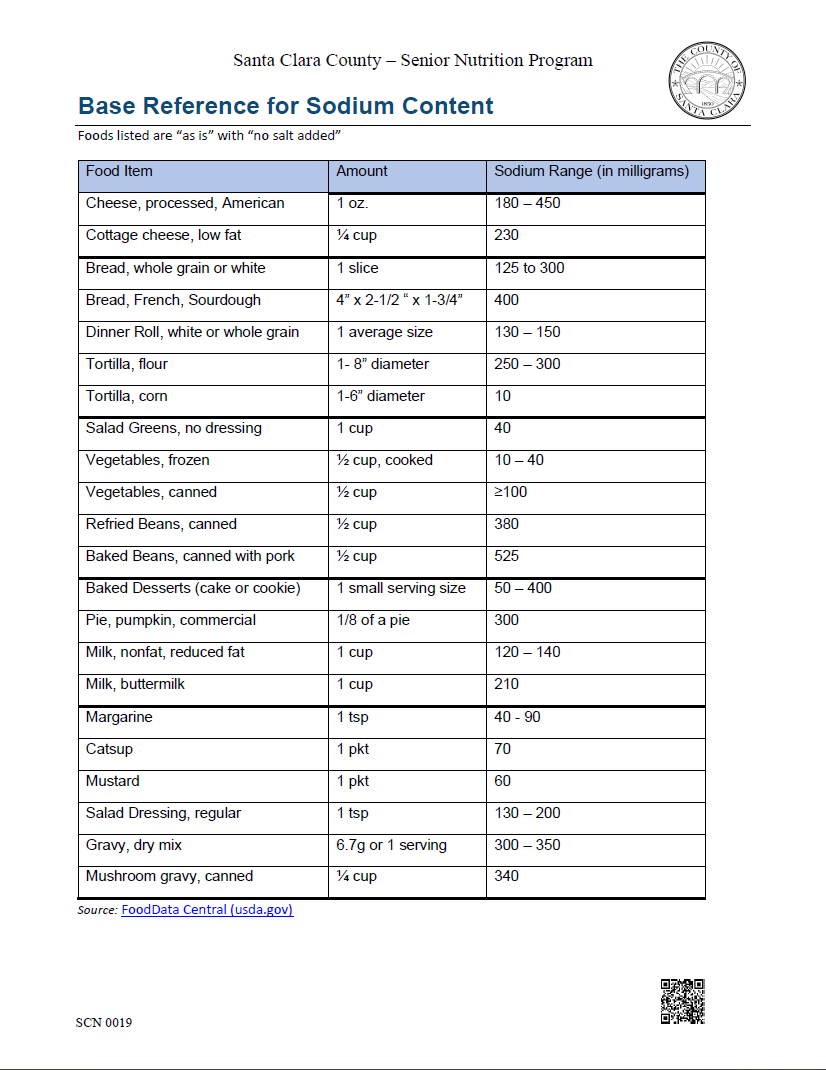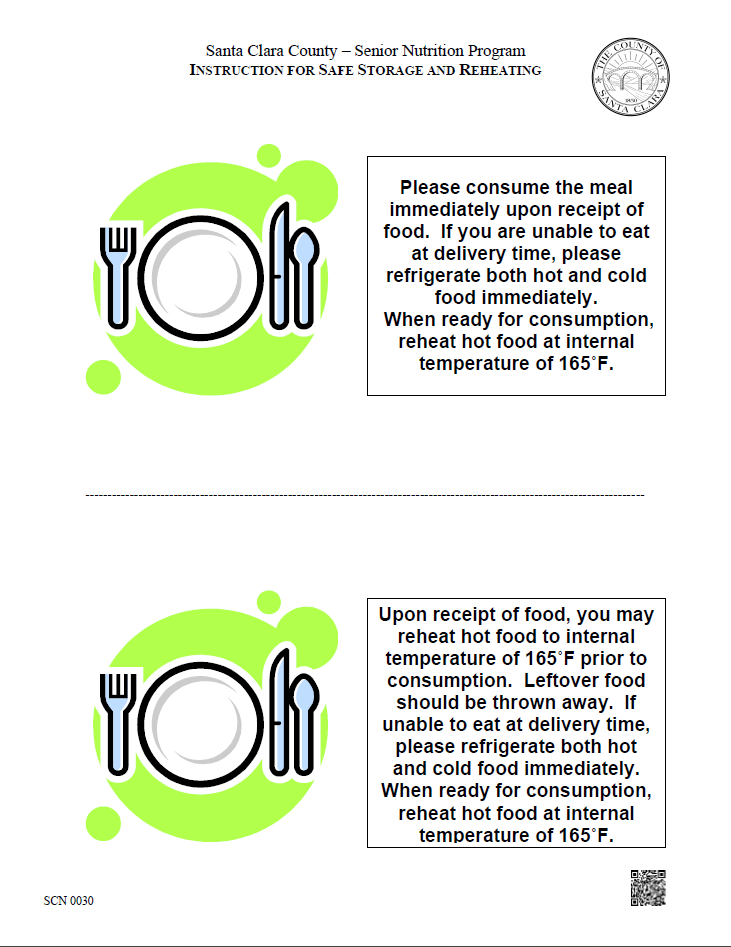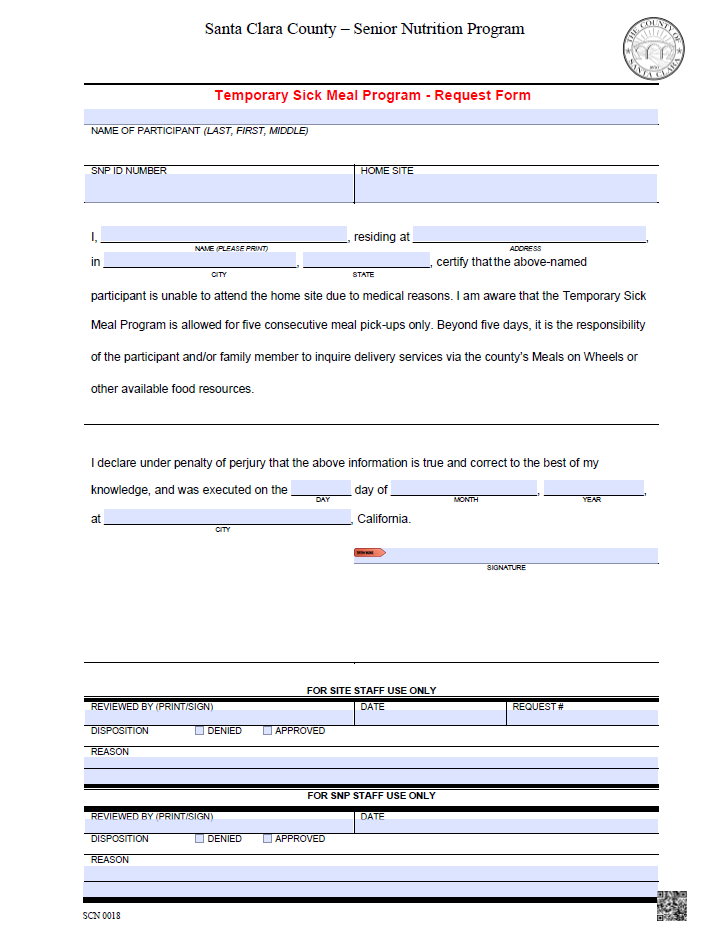Menu Requirements
Nutrition Requirements of Meals
- Compliance with Dietary Guidelines
The Older Americans Act requires that meals comply with the current Dietary Guidelines for Americans (DGA) published by the Secretary of Health and Human Services and the Secretary of Agriculture.
Each participating older individual shall be provided with meals that meet nutritional standards. If the program provides:- One meal per day, a minimum of 1/3 of the Dietary Reference Intake (DRI) shall be offered.
- Two meals per day, a minimum of 2/3 of the Dietary Reference Intake (DRI) shall be offered.
- Three meals per day, one hundred percent (100%) of the Dietary Reference Intake (DRI) shall be offered.
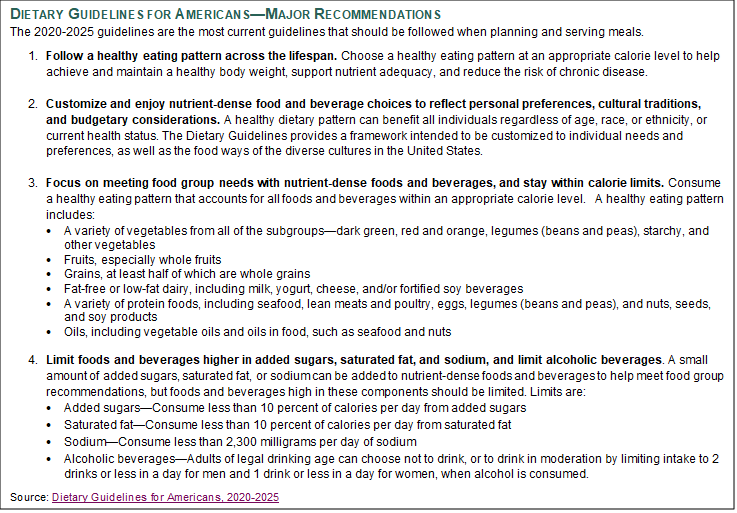
Source: Dietary Guidelines for Americans, 2020-2025
- Menu Analysis and Approval
Conformity to the menu requirements shall be assured by computerized nutrient analysis or use of the component pattern and approved by a Santa Clara County SNP Dietitian to ensure compliance with subsection (1) above.- A computerized nutrient analysis can be used to plan meals for congregate meal sites. The following nutrients must be included in the analysis: calories, protein, carbohydrates, total fat, saturated fat, total fiber, vitamins—A, C, E, K, thiamin, riboflavin, niacin, B6, folate, B12; and minerals—calcium, chromium, copper, iron, magnesium, sodium, zinc. In addition, the SNP requires nutrient analysis for vitamin D and potassium.
- The program’s meal pattern component shall follow key nutrients outlined in Meal Planning Requirements including the following:
- Vitamin A
- A Vitamin A rich food shall be served at least one (1) time per week for three (3) days a week menu, two (2) times per week for four (4) days a week menu, three (3) times per week for a five (5) days a week menu and four (4) times per week for a seven (7) days a week menu.
- A Vitamin A rich food is a single serving or a combination of servings in the same meals that contains a minimum of 233 µg (retinol equivalents).
- A list of Vitamin A rich foods is found in Form: Vitamin A Vegtables and Fruits.
- Vitamin C
- A vitamin C rich food or vegetables will be served daily and will provide 1/3 of the Dietary Reference Intake (DRI) or 25 mg each meal.
- A vitamin C rich food is a single serving or a combination of servings at the same meal.
- A list of vitamin C rich foods is found in Form: Vitamin C Vegtables and Fruits.
- Vitamin A
- Meal Planning Requirements
The Dietary Guidelines for Americans, published by the U.S. Department of Agriculture (USDA) and U.S. Department of Health and Human Services (USDHHS), are to be considered when planning menus. Below are key nutrients when planning menus using the Meal Pattern Components. A summary of the requirements can be found in Form: Summary Menu Requirements 2022.- Kilocalories
- Menus shall provide an average of at least 533 kilocalories (kcal) per meal.
- Protein – Meat, Fish, Poultry, Legumes, Eggs and Cheese
- The meal shall contain a minimum of 3 ounces (per County) of cooked, edible portions of meat, fish, seafood, poultry, legumes, beans, peas, soy products, nuts, seeds, eggs, cheese OR a combination thereof providing at least 15 grams of protein.
- Mixed main entrees such as casseroles, pastas and entrée salads should provide at least 15 grams of protein.
- Use legume dishes (using mature dried beans such as lima, kidney, navy, black, pinto or garbanzo beans, lentils, peas, black eyed peas, and soybeans) as often as possible in accordance with participants’ acceptance.
- Legume dishes should not be counted as both a vegetable and a protein in the same meal.
- Alternate protein sources are healthy options to include in the menu. The SNP recommends at least one vegetarian meal per week. A list of lean and healthy protein sources is found in Form: Lean Healthy Protein Sources.
- Portion controlled items and other convenience foods (e.g., fish fillet, pork chop, stuffed peppers and cabbage, lasagna, or chile relleno) must contain no more than 480 mg. sodium per serving. (County guideline).
- Extra lean beef and pork (total fat ≤ 5%) and at least 90% lean ground beef is recommended.
- The County recommends the use of lean ground meat in entrees no more than twice a week. If served twice in one week, the ground meat shall be served at least once in “solid” form such as meat loaf or Salisbury steak.
- Imitation cheese cannot be served as meat alternates.
- Breads/Grains
- Each meal shall contain one to two servings of grains. One serving must be a whole grain.
- Breads and baked goods must contain less than 215 mg sodium per serving.
- A variety of whole grain products should be consumed. Those highest in fiber are recommended: barley, brown rice, bulgur, dried ground corn (cornmeal, masa), oats, quinoa, whole rye, whole wheat, and wild rice.
- A list of whole grain foods is found in Form: Whole Grains.
- Vegetables
- Each meal shall contain at least 1 to 2 servings of vegetables, drained weight or volume of vegetables. (½ cup = 1 serving).
- Raw leafy vegetables must equal 1 cup per serving.
- Use fresh or frozen vegetables 3 – 4 times per week (60 – 80%). Minimize use of canned products. If canned vegetables are used, a serving should contain no more than 290 mg sodium.
- Vegetables as a primary ingredient in soups, stews, casseroles, or other combination dishes must total ½ cup per serving (in order to be counted as a vegetable serving).
- Potatoes, sweet potatoes, yams, and corn are considered as vegetables, not bread/grain.
- Legume dishes should not be counted as both a vegetable and a protein in the same meal.
- Fruits
- Each meal shall contain at least 1 serving of fruit. A serving of fruit is generally:
- One medium sized whole fruit (i.e., the size of a tennis ball); OR
- 2 – Small sized whole fruits; OR
- ½ cup fresh, chopped, cooked, frozen or canned, drained fruit, OR
- ½ cup 100% fruit juice.
- Serve fresh or frozen fruit at least 3 times per week.
- Canned fruit should be packed in juice, light syrup or without sugar.
- Fruit may be used as a fruit serving and a dessert in the same meal.
- Each meal shall contain at least 1 serving of fruit. A serving of fruit is generally:
- Milk and Approved Milk Substitutes
- Each meal shall contain eight (8) ounces of fortified (Vitamin A & D) skim (fat free), low-fat, lactose-free milk, or buttermilk (maximum of 1% milk fat).
- If religious, cultural, or ethnic preference precludes the acceptance of milk with the meal, it may be omitted from the menu. However, an equivalent substitute should be served, such as eight (8) ounces of calcium fortified soy milk, calcium fortified orange juice, or low-fat yogurt. (State guideline) The “offer versus served” option may also be used.
- According to Santa Clara County Nutrition Standards, flavored milk, such as vanilla or chocolate shall not be served. Calcium fortified plant derived milk such as soy, rice, or almond shall contain ≤130 calories per 8 oz. serving.
- All milk and approved milk substitute products shall be pasteurized.
- Fat
Fat is not a requirement. However, each meal may contain fat components to increase the palatability or acceptability of the meal. Healthy fats can be used in food preparation or served as an accompaniment to the meal when appropriate. The type of fat makes a difference to heart health and the total amount of fat consumed is also important.- Consume less than 10 percent of calories from saturated fatty acids and less than 300 mg/day of cholesterol.
- Keep total fat intake between 20 to 35 percent of calories, with most fats coming from sources of polyunsaturated and monounsaturated fatty acids, such as fish, nuts, and vegetable oils such as olive and canola.
- When selecting and preparing meat, poultry, and milk or milk products, make choices that are lean, low-fat, or fat-free.
- Limit intake of fats and oils high in saturated fat and choose products low in such fats and oils.
- Products with trans-fatty acids may not be used or served.
- Shortening, lard, butter or other hydrogenated fats are not to be used in cooking or offered with the meal.
- Dessert
- Dessert is OPTIONAL but may be served no more than one time per week.
- Use fruit as a dessert as often as possible, limit sweets.
- Consider serving smaller portions of desserts such as cookies, cakes and other baked goods.
- Angel food cake, sorbet, and frozen 100% juice bars are specifically considered by the County as acceptable desserts.
- Desserts that are low in fat or low in sugar are encouraged.
- When a dessert contains ½ cup of fruit per serving, it may be counted as a serving of fruit
- Condiments
- Traditional meal condiments can be served as appropriate, e.g., tartar sauce with fish, mustard and mayonnaise with a meat sandwich, salad dressing with tossed salad, margarine with bread and rolls.
- Salt substitutes shall not be provided.
- Sugar substitutes, pepper, herbal seasonings, lemon, vinegar, non-dairy coffee creamer, may be provided but should not be counted as fulfilling any part of the nutritive requirements.
- Sodium
The commitment to reduce sodium in the meals stems from the fact that nutrition related chronic diseases remain the primary cause of death among people aged 65 and older. California has a diverse population, and the Elderly Nutrition Programs (ENPs) in the State provide culturally appropriate meals for many ethnicities.- The recommended amount of sodium for an individual meal is less than 800 mg.
- The maximum amount of sodium allowed for an individual meal is 1200 mg.
- Meals that have more than 1000 mg sodium on the menu must state: “This meal contains more than 1000 mg of sodium” or be identified with an icon noting that it is a high sodium meal.
- For all cuisines:
- Use only low sodium versions of high sodium foods and seasonings (such as salad dressings, gravies, soup bases, soy sauce) when available and feasible within budget allowances.
- Use of low sodium items wherever possible assuming cost neutrality.
- Omit salt in a recipe or be limited to ¼ or less than the amount required.
- Use herbs, spices, and seasonings without added salt.
- Rinse food items packaged with sodium as a preservative (e.g., beans or tuna).
- Iodized salt should be used in cooking or when made available to clients.
- Use low sodium soy sauce or diluting soy sauce with water to produce low sodium soy sauce.
- Consider removing saltshakers from the tables to a designated condiment table to discourage older adults from adding more salt to their plates.
- Refrain from using food items such as raw chicken with sodium preservatives.
- For menu planning, may use guidance from Form: Base Reference for Sodium Content.
- Therapeutic Meals
Nutrition service providers may offer therapeutic meals where it is feasible, appropriate, and cost effective. Meals for participants who require therapeutic diets may be offered only when the modified meal can be obtained from a facility where a registered dietitian-nutritionist approves the meals. - Modified Textured Meals
Modifying food texture and consistency may help older adults with chewing and swallowing problems. Chopping, grinding, pureeing, or blending foods are common ways to modify food textures. Texture modified food has the same nutritive value of solid foods and it can be just as tasty and appealing. Serving size should account for any dilution to the food items during preparation. The provision of such foods should be planned and approved by the county registered dietitian nutritionist. - Food Allergens
CalCode section 113947 requires the “person in charge” and all food employees to have adequate knowledge of food safety as it relates to their assigned duties. The person in charge shall comply with both of the following:- Have adequate knowledge of major food allergens, food identified as major food allergens, and the symptoms that a major food allergen could cause in a sensitive individual who has an allergic reaction.
- Educate the employees regarding the information by using a poster or job aid to which the employee can refer.
- Supplements
Vitamin and/or mineral supplements shall not be provided. Medical foods and food for special dietary uses shall not be provided with federal or state nutrition funds. - Ethnic Meals
- Ethnic customs can influence food preferences. Use bilingual staff, volunteers and/or interpreters to plan menus and program ideas.
- Provide authentic ethnic cuisine if applicable.
- May use an ethnic caterer or restaurant to serve specific ethnic communities.
- Introduce new foods to coincide with ethnic and religious holidays.
- Include community input when planning menus.
- Offer variety of meals and/or foods from different ethnic groups.
- Beverages
- Fluid intake should be encouraged as dehydration is a common problem in older adults. It is a good practice to have drinking water available. Use fruit or vegetable infused water to promote hydration.
- Alcoholic beverages should not be provided.
- Kilocalories
Menu Planning and Writing Process
- Menu Planning
- Menus need to be planned for a minimum of five (5) weeks or up to seven (7) weeks. Menu template for Meal component can be found on Form: Meal Pattern Components
- Menus are written or updated by the Site Manager by consulting with the cook or caterer. Menu ideas are incorporated according to the older adults’ food preferences from food surveys, focus groups, advisory council, suggestion box, production needs, food costs, and availability of food items. Reflect cultural and ethnic dietary needs of participants, when feasible and appropriate.
- Food items should not be repeated two days in a row or on the same days of consecutive weeks except when preferred by the participants receiving the meals.
- Menus are submitted to the assigned SNP dietitian for review and corrections to assure compliance with the Menu Guidelines according to the OAA Title III-C.
- Final menus shall be approved and provided by the assigned dietitian.
- Sites shall use approved menus for meal preparation. A copy of the menu must be posted in the kitchen.
- Client facing menu shall be created and translated to the primary language of the participants; and posted in the site's dining room. Menus should match with the approved master menu with icons indicated for high sodium and/or vegetarian meals. Client Facing Menu must be submitted to SNP on a monthly basis.
- Menu Substitution(s)
- Substitutions should be comparable in nutrient content to the original menu items.
- Menu substitution(s) shall be made because of:
- Natural disaster causing food production and food delivery to be disrupted;
- Food storage due to non-delivery of product;
- Sudden increase of price(s) of a planned menu item(s);
- Unexpected staffing shortage;
- Appropriate use of donated food;
- Appropriate use of leftover food;
- Special holidays or festivals;
- Overwhelming negative response by participants;
- Unexpected contamination of food;
- Dietitian's recomended. changes to improve food quality and/or menu combinations.
- If there is adequate time, Site Manager and/or cook must consult with assigned dietitian for approval of menu changes.
- Site Manager and/or cook must refer to the Menu Guideline reference for menu substitutions (especially for Vitamins A and C rich food sources, or whole grains).
- Changing one menu item may result in altering other menu items—i.e. altering the sodium content of a meal. All factors of menu planning should be considered when making substitutions. The posted menus and/or monthly menu should also be changed to reflect the substitutions. Site staff and participants should also be informed of the change(s).
- The actual menu item(s) served must be written on the menu or food temperature log and submitted monthly to the assigned dietitian.
- The assigned dietitian reviews the monthly menus and when necessary, discusses with Site Manager and/or cook the appropriate recommendations regarding substitutions made.
- Menus are kept on file at the site and Senior Nutrition Program office for audit purposes.
- Instructions for Portion Control
- Weigh and measure out a sample meal before starting to serve participants.
- Standard portions are important because:
- Participants are served the same amount.
- Food costs can be controlled.
- There will be enough servings.
- Leftovers are minimized.
- When feasible, mark all utensils with size or number.
- Use portion scales to weigh meat and fish.
- Three (3) ounces of cooked meat (without bone or fat) = 1 serving or 1 portion.
- In mixed dishes such as casseroles, ALL ingredients may be included to meet the protein requirement.
- Scoops may be used for portioning items such as ground meat patties, cooked rice, cooked vegetables, salads, and sandwich fillings.
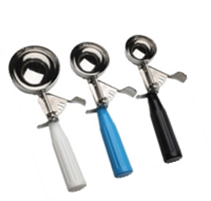
Scoop Number Level Measure 6 2/3 cup 8 1/2 cup 12 1/3 cup 16 1/4 cup - Ladle may be used in serving soups, creamed dishes, stews, sauces, gravies, and other similar products. The following sizes of ladles are most frequently used for serving:
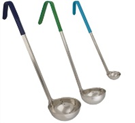
Ladle Number (oz.) Level Measure 1 oz. 2 Tablespoon 2 oz. 1/4 cup 6 oz. 3/4 cup 8 oz. 1 cup
- Spoodles are portion controlled spoons to measure dry “volume”. Spoodles with holes in the bottom are especially useful to serve cooked vegetables so that the liquid can drain out before serving. Spoodles are commonly used to serve cooked vegetables.
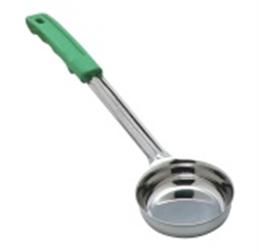
Spoodle Number (oz.) Level Measure 2 oz. 1/4 cup 4 oz. 1/2 cup 6 oz. 3/4 cup 8 oz. 1 cup - Serving Spoons (solid or perforated) may be used instead of a scoop. Since these spoons are not identified by serving sizes, it is necessary to measure or weigh the food to obtain the approximate serving size desired. After sample meal is portioned out, a serving spoon may be used if more convenient.
- Measuring cups should be used while measuring out ingredients for the recipes.
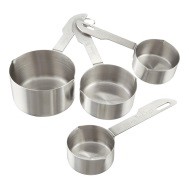
Servings Sizes 1 cup 8 oz. 16 Tablespoons 3/4 cup 6 oz. 12 Tablespoons 1/2 cup 4 oz. 8 Tablespoons 1/4 cup 2 oz. 4 Tablespoons
NOTE: Use serving utensils or plastic gloves for all food without peel or wrap. Do not use bare hands.
Recipe Conversion Chart
Fractional Equivalents for use in converting recipes
The following chart is designed to help change fractional parts of pounds, gallons, cups, etc., to accurate weights or measures. For example, reading from left to right, the table, 1/3 of a gallon is 1 quart plus 1 – 1/3 cups; 1/16 of a cup is 1 tablespoon; etc.
|
|
1 TABLESPOON |
1 CUP |
1 PINT |
1 QUART |
1 GALLON |
1 POUND |
|
1 |
3 tsp |
16 Tbsp |
2 cups |
2 pints |
4 quarts |
16 ounces |
|
3/4 |
2 – 1/4 tsp |
12 Tbsp |
1 – 1/2 cups |
3 cups |
3 quarts |
12 ounces |
|
2/3 |
2 tsp |
10 Tbsp plus 2 tsp |
10 Tbsp plus 2 tsp |
1 – 1/3 cups |
2 quarts plus 2 – 2/3 cups |
10 – 2/3 ounces |
|
1/2 |
1 – 1/2 tsp |
8 Tbsp |
1 cup |
2 cups |
2 quarts |
8 ounces |
|
3/8 |
1 - 1/8 tsp |
6 Tbsp |
3/4 cup |
1 – 1/2 cups |
1 quart plus 1 pint |
6 ounces |
|
1/3 |
1 tsp |
5 Tbsp plus 1 tsp |
2/3 cup |
1 – 1/3 cups |
1 quart plus 1 – 1/3 cups |
5 – 1/3 ounces |
|
1/4 |
3/4 tsp |
4 Tbsp |
1/2 cup |
1 cup |
1 quart |
4 ounces |
|
1/8 |
1/2 tsp (scant) |
2 Tbsp |
1/4 cup |
1/2 cup |
1 pint |
2 ounces |
|
1/16 |
1 tsp |
1 Tbsp |
2 Tbsp |
4 Tbsp |
1 cup |
1 ounce |
Recipe Guidelines
- Standardized Recipe Components
The following components are required in a standardized recipe:form 16- Recipe Title
- Yield
- Ingredients
- Directions
|
RECIPE COMPONENT |
GUIDELINE |
|
Title |
The name that describes the recipe; it must be the same name used on the menu. |
|
Yield |
The total amount of serving portions in volume and/or weight along with the correct serving size. |
|
Ingredients
|
Specific products used in recipe; preferably listed in order of use. |
|
Only use low and/or less sodium products; refer to chart below. |
|
|
To follow the recommended total fat amount per meal, look for ground beef products that are no less than 80/20 (80% lean beef and 20% fat). If not available, substitute 50% or more of the ground beef in the recipe with an alternate low-fat protein. |
|
|
Directions
|
Detailed information on how to prepare the recipe and equipment needed. Cooking temperatures, cooking methods, time needed to prepare, cooling, and holding temperatures should be addressed in these directions. |
|
Critical control points (CCP) are identified to reduce or eliminate potential food hazards. For example, temperature control points for chicken must be heated to at least 165°F. Leftover food must be safely cooled down to 70°F before cold storage. |
- Monitor Sodium Usage
When preparing meals, it is recommended to use less and/or low sodium ingredients.
|
Product |
Amount |
Sodium Level (mg) |
|
Soy Sauce
|
1 TBSP |
920mg |
|
1 TSP |
307mg |
|
|
Less Sodium Soy Sauce
|
1 TBSP |
575mg |
|
1 TSP |
192mg |
|
|
Chicken Base
|
¾ TSP = 1 cup prepared |
770mg |
|
16 oz. (1 LB) |
365mg (per 100 servings) |
|
|
Low Sodium Chicken Base
|
¾ TSP = 1 cup prepared |
130mg |
|
16 oz. (1 LB) |
63mg (per 100 servings) |
|
|
Vegetable Base
|
¾ TSP = 1 cup prepared |
630mg |
|
16 oz. (1 LB) |
302mg (per 100 servings) |
|
|
Low Sodium Vegetable Base
|
¾ TSP = 1 cup prepared |
115mg |
|
16 oz. (1 LB) |
55mg (per 100 servings) |
|
|
Beef Base
|
¾ TSP = 1 cup prepared |
800mg |
|
16 oz. (1 LB) |
384mg (per 100 servings) |
|
|
Less Sodium Beef Base
|
¾ TSP = 1 cup prepared |
135mg |
|
16 oz. (1 LB) |
64mg (per 100 servings) |
|
|
Margarine |
1 TSP |
37mg |
|
Pre-made Coleslaw Dressing |
1 oz. |
323mg |
|
Mayonnaise |
1 oz. |
200mg |
*Based on 2,000 kcal/day, sodium levels vary by brand; Source: USDA National Nutrient Database-Sodium
- Monitor Total Fat
- Fat is generally used as a staple for flavoring, as a cooking medium, and as an ingredient in many recipes.
- Limit high saturated fat and choose products that are low in fats and oils. Recommend using products with less than 10% of calories from saturated fat and limit using products that have >10%.
- SNP does not recommend the use of margarine in cooking. May serve margarine on the side with bread or rolls.
|
Product |
Amount |
Saturated Fat % Daily Value |
|
Extra Virgin Olive Oil |
1 TBSP |
6% |
|
Canola Oil |
1 TBSP |
2% |
|
80/20 Ground Beef |
4 oz. (raw) |
20% |
|
85/15 Ground Turkey |
4 oz. (raw) |
7% |
*Based on 2,000kcal/day Source: USDA National Nutrient Database-Total Fat
Standardized Recipe Form
Standardized Recipe Form (Sample)
RECIPE: Pineapple Tofu
NUMBER OF PORTIONS: 125 SIZE OF PORTIONS: 12 oz.
COOKING TEMPERATURE: 145°F COOKING TIME: 45 mins
|
INGREDIENTS |
MEASURE |
|
Sliced onions |
3/4th lbs. |
|
Stir-fry vegetables (carrots, broccoli, assorted bell peppers) |
18 lbs. |
|
Bean sprouts |
10 lbs. |
|
Mushrooms |
10 lbs. |
|
Pineapple chunks |
2 #8 can |
|
Soft tofu, cubed |
36 lbs. |
|
Sweet and sour sauce |
1.5 gallon |
|
Spring onions for garnish |
|
METHOD:
- Sauté sliced onions, bean sprouts, and mushrooms.
- Add stir fry vegetables and continue to cook for 5 minutes.
- Drain and add the pineapple chunks.
- Add cubed tofu.
- Pour sweet and sour sauce and mix well.
- Garnish with spring onions and serve.
NUTRITIONALS:
1 cup tofu (1/2" cubes) =17gm protein
Recipe Courtesy: Salvation Army Senior Nutrition
Emergency Meals
Congregate sites shall have emergency meal plan in place. See sample meals below.
Sample Emergency Menu for Cook-on Sites
(The following menu items usually available in stock)
Tuna Salad Sandwich:
- 2 ½ oz. Canned Tuna (packed in water)
- 1 Tbsp. Low Fat or Fat Free Mayonnaise
- 2 slices Bread (preferably Whole Grain)
- ½ cup Canned Three Bean Salad
- ½ cup Canned or Fresh Fruit*
- 8 oz. Fat-Free or Low-Fat Milk (non-flavored)
Sample Emergency Menu for Catered or Cook-on Sites
KFC (Kentucky Fried Chicken):
- Grilled Chicken (1 Thigh=17 gm protein OR 1 Drumstick AND 1 Wing=23 gm protein)
- ½ cup Mashed Potatoes*
- ½ cup Coleslaw*
- ½ cup Fruit or 100% Fruit Juice
- 8 oz. Fat-Free or Low-Fat Milk (non-flavored)
SUBWAY:
- 6” Turkey and Cheese Sandwich on Honey Oat Bread
- 1 cup Lettuce, Tomatoes, Cucumbers, Green Bell Peppers, Spinach, and Onions
- ½ cup Fruit or 100% Fruit Juice
- 8 oz. Fat-Free or Low-Fat Milk (non-flavored)
*One of these items may be substituted for ½ cup 100% Fortified Vitamin C Juice.
Temporary Sick Meal Program
Temporary sick meals may be available to congregate participants for five consecutive days during short-term confinement at home while recovering from illness.
- Guidelines for Determining Who Receives Temporary Sick Meals
- Meals are available to a regular participant who is temporarily ill and unable to come to the site.
- A Temporary Sick Meal Program (TSMP) form must be completed and approved (Form: Temporary Sick Meal Program)
- The individually packaged meal shall be received only by the designated person.
- Meals are available for five days or until such service can be provided through the Home Delivered Meals Program or Meals on Wheels (MOW).
- Site Manager’s Responsibilities
- Confirm that the individual is ill and is unable to prepare his/her own meal.
- If feasible, provide hot meals delivered to the person’s home.
- Provide the person delivering the meal with a contribution envelope. Client shall use an envelope for confidential contribution. Include any amount collected into the contribution count for the day.
- Add the person’s name onto the registration sheet and scan the barcode from the roster.
- Include recipient of temporary sick meal in number of meals served at site.
- If unable to deliver meals to the Homebound person or if the eligible older adult is expected to be Homebound for more than five days, Site Manager shall make referrals to the County’s Home Delivered Meal Program.
- Pack Out Procedure
- Hot and cold foods shall be packed separately in appropriate covered containers.
- Pack hot food in aluminum or Oliver’s beige 3-compartment container. Crimp on lid with white side up.
- Pack out cold food in container covered with plastic wrap.
- Provide instructions (Form: Instruction Safe Storage and Reheating) with the pre-packaged meal for safe storage and reheating.
- Hot food shall be packed out at as high a temperature above 160˚F, or as is reasonable for the meal served.
- Cold food shall be packed out at temperature below 41˚F.
- Hot and cold food containers shall be transported in separate thermal carriers.
- Meals will be packed out no later than 15 minutes before time of delivery. If unable to deliver after pack out, refrigerate meals immediately.
- Delivery Person
- Shall be the site staff or volunteer.
- Shall have:
- Current driver’s license.
- His or her own vehicle (if volunteering as driver).
- Current, adequate liability insurance coverage.
Forms
Form: Vitamin A-Vegetables and Fruits
Source: Food Composition/National Agricultural Library(usda.gov)
Form: Vitamin C – Vegetables and Fruits
Form: Summary of Menu Requirements 2022
Form: Lean and Healthy Protein Sources
Source: http://www.todaysdietitian.com/pdf/webinars/ProteinContentofFoods.pdf
Source: Vary Your Protein Routine
Form: Whole Grains
Source: https://wholegrainscouncil.org/sites/default/files/atoms/files/WGC-WholeGrainsAtoZ2017.pdf
Form: Base Reference for Sodium Content of Commonly Served Foods in the SNP
Source: USDA Food Composition Database at FNIC Homepage (usda.gov)
Form: Meal Pattern Components
Form: Instruction for Safe Storage and Reheating
Form: Temporary Sick Meal Program
